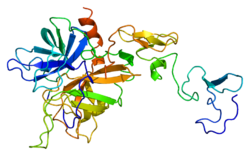Protein C
| Protein C | ||
|---|---|---|

|
||
| Properties of human protein | ||
| Mass / length primary structure | 417 = 155 + 262 amino acids | |
| Secondary to quaternary structure | Heterodimer | |
| Cofactor | Vitamin K | |
| Precursor | 419 amino acids | |
| Identifier | ||
| Gene names | PROC ; PROC1 | |
| External IDs | ||
| Drug information | ||
| ATC code | B01 AD12 | |
| Drug class | anticoagulant | |
| Enzyme classification | ||
| EC, category | 3.4.21.69 , serine protease | |
| MEROPS | S01.218 | |
| Substrate | Factor Va; Factor VIIIa | |
| Occurrence | ||
| Homology family | Trypsin | |
| Parent taxon | Creature | |
| Orthologue | ||
| human | House mouse | |
| Entrez | 5624 | 19123 |
| Ensemble | ENSG00000115718 | ENSMUSG00000024386 |
| UniProt | P04070 | P33587 |
| Refseq (mRNA) | NM_000312 | NM_008934 |
| Refseq (protein) | NP_000303 | NP_032960 |
| Gene locus | Chr 2: 127.89 - 127.9 Mb | Chr 18: 32.27 - 32.28 Mb |
| PubMed search | 5624 |
19123
|
Protein C is a vitamin K -dependent protein in (human) blood plasma . It is synthesized in the liver as an inactive precursor and, after activation, acts as a serine proteinase.
The effect of this protein was discovered in 1960 by the German physician Eberhard Mammen . In the following ten years, a number of hemostaseologists (specialists in blood coagulation) researched the further relationships between protein C as part of a complex regulatory system that is of crucial importance for the physiological process of blood coagulation ( hemostasis ), i.e. healthy functioning.
There are basically three physiological functions ascribed to protein C:
- anticoagulant effect (anti-coagulant),
- profibrinolytic effect (dissolves blood clots),
- anti-inflammatory effect (anti-inflammatory).
Blood coagulation ( hemostasis ) occurs in normal function at the lesion, trauma, or injury. Thus, however, the blood does not coagulate uncontrollably also uninjured in the vascular system, binds thrombin (factor IIa) of thrombomodulin of endothelial cells of the blood vessel and thereby activated protein C to the so-called activated protein C (APC). Activated protein C complexes with protein S in order to inactivate the coagulation factors FVa and FVIIIa in the free bloodstream by proteolysis. Protein S acts as a cofactor (helping factor) for protein C. The complex ultimately acts as a physiological anticoagulant (blood coagulant).
A protein C concentrate made from blood plasma is available under the trade name Ceprotin for the treatment of congenital protein C deficiency and coumarin necrosis . Recombinantly produced protein C is available as a medicinal substance under the generic name Drotrecogin ; a corresponding drug was approved in the EU from 2002 to 2011 for the treatment of severe sepsis .
Protein C has in the anticoagulation treatment with vitamin K - antagonists an important effect. At the start of therapy, not only are the formation of vitamin K-dependent coagulation factors (II, VII, IX and X) inhibited, but protein C and protein S. Protein C has a significantly shorter half-life than most coagulation factors (6 h vs. 60 h for factor II), which ensures that after the start of therapy, the concentration of biologically active protein C drops significantly faster than z. B. of factor II. This increases the coagulation and thus the risk of thrombosis initially. This must be prevented by overlapping therapy with a heparin for a few days.
Trade names
Beriplex (D, A, CH), Octaplex (D, A, CH), PPSB-human SD (D), Prothromplex (A), Desonstaplex (CH, A)
See also
Individual evidence
- ↑ T. Mather, V. Oganessyan, P. Hof, R. Huber, S. Foundling, C. Esmon, W. Bode: The 2.8 A crystal structure of Gla-domainless activated protein C. In: The EMBO journal. Volume 15, Number 24, December 1996, pp. 6822-6831, PMID 9003757 . PMC 452507 (free full text).